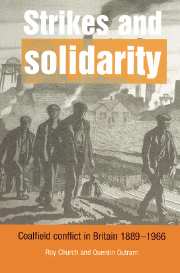Book contents
- Frontmatter
- Contents
- List of figures and tables
- Preface
- List of abbreviations
- 1 Interpreting coalfield conflict: focus and formulations
- 2 Tradition and modernity: the mining industry 1889–1940
- 3 Employers and workers: organizations and strategies
- 4 Employers and workers: ideologies, attitudes and political orientations
- 5 Configurations of strike activity
- 6 Strike participation and solidarity before 1912
- 7 Strikes, organization and consciousness in 1912 and after
- 8 Conflictual context? The ‘isolated mass’ revisited
- 9 Mining and modernity: size, sectionalism and solidarity
- 10 The foundations of strike propensity
- 11 Miners and management: agency and action
- 12 Industrial relations and strikes after nationalization
- 13 International perspectives
- 14 Myths and realities: strikes, solidarity and ‘militant miners’
- General appendix
- List of references
- Index
11 - Miners and management: agency and action
Published online by Cambridge University Press: 04 December 2009
- Frontmatter
- Contents
- List of figures and tables
- Preface
- List of abbreviations
- 1 Interpreting coalfield conflict: focus and formulations
- 2 Tradition and modernity: the mining industry 1889–1940
- 3 Employers and workers: organizations and strategies
- 4 Employers and workers: ideologies, attitudes and political orientations
- 5 Configurations of strike activity
- 6 Strike participation and solidarity before 1912
- 7 Strikes, organization and consciousness in 1912 and after
- 8 Conflictual context? The ‘isolated mass’ revisited
- 9 Mining and modernity: size, sectionalism and solidarity
- 10 The foundations of strike propensity
- 11 Miners and management: agency and action
- 12 Industrial relations and strikes after nationalization
- 13 International perspectives
- 14 Myths and realities: strikes, solidarity and ‘militant miners’
- General appendix
- List of references
- Index
Summary
A close reading of the few existing studies which explore labour relations in detail at company, pit and community levels in our period tends to reinforce a scepticism to a search for a general explanation of colliery strikes, an attitude to which we alluded in chapter 3. For example, studies of two Northumberland collieries, Ashington and Throckley, by Dintenfass (1985), revealed a similar history of low strike activity over many decades, though punctuated by a brief period of labour unrest shortly after the First World War. The approach to labour management in the two collieries, however, was in the sharpest contrast. The owners and managers of Ashington colliery cultivated a harmonious community through an acceptance of trade unionism and a paternalist welfare policy which, after a period of labour unrest and under a new manager, included publication of The Ashington Colliery Magazine, which occasionally editorialized on the theme of ‘team spirit’. Layoffs and short-time working resulting from pit closures and colliery reorganization were accepted by the union branch as a better alternative to wage cuts (Dintenfass 1985: 257–74). At Throckley a limited provision of institutional and other forms of welfare was combined with what Dintenfass has described as ‘tight-fisted and hard-nosed’ management methods. These included victimization of workers after strikes in 1926 and 1928, a continued preference for recruiting non-union labour, vindictive, petty deductions from wages, and non-co-operation with the union's own welfare programme. Another contrast between the two collieries was in investment and technical change.
- Type
- Chapter
- Information
- Strikes and SolidarityCoalfield Conflict in Britain, 1889–1966, pp. 196 - 218Publisher: Cambridge University PressPrint publication year: 1998



